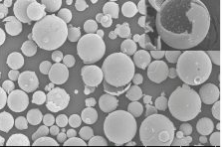

The melting point of yttria-stabilized zirconia powder is as high as 2450 degrees Celsius. This physical property also determines that this powder is not friendly to plasma spraying systems. It needs downstream coating companies to optimize parameters to make the powder work normally and form an ideal heat. barrier coating.
Through research and development, we have prepared a powder with a hollow structure. Compared with solid powder, hollow yttria-stabilized zirconia yttria is more friendly to thermal spray systems: it is easier to melt during plasma spraying, and after melting, hollow droplets are formed, and the flat particles formed by deposition on the substrate The layer thickness is uniform and the defects are few.
Usually, we use 8YSZ to prepare thermal barrier coatings for the purpose of protecting the superalloy substrate with a melting point of 1350 degrees Celsius under a working environment of 1600 degrees Celsius. The columnar microcrack structure of the coating is its low thermal conductivity and high heat resistance. The key to seismic performance is the hollow powder coating, and the columnar microcracks of the coating prepared by hollow powder are uniform and moderate. The hollow powder coating will neither have high porosity nor reduce the bonding strength between gradient coatings. Preferred materials for barrier coatings.
On the other hand, we often use 20YSZ to prepare graphite crucibles to resist melting corrosion and thermal shock when melting superalloys. Compared with the solid powder, the hollow 20YSZ powder melts more thoroughly in the plasma flame, and forms sputter-like flat droplets at the moment of deposition on the substrate, which can reduce the porosity of the coating and reduce the metal melting. The liquid is in contact with the graphite matrix to avoid the generation of hot steam and carbides to contaminate the molten metal itself.
It should be noted that the thermal expansion coefficient of the graphite crucible is not an order of magnitude with that of YSZ, so it is necessary to use a metal molybdenum coating as a primer to make the thermal expansion coefficient between the three converge; For preheating, the temperature is generally about 450 degrees Celsius.
The article on this page is original, please inform us if you reprint it. If there is plagiarism, its shameful behavior will be cracked down.

Hot information

